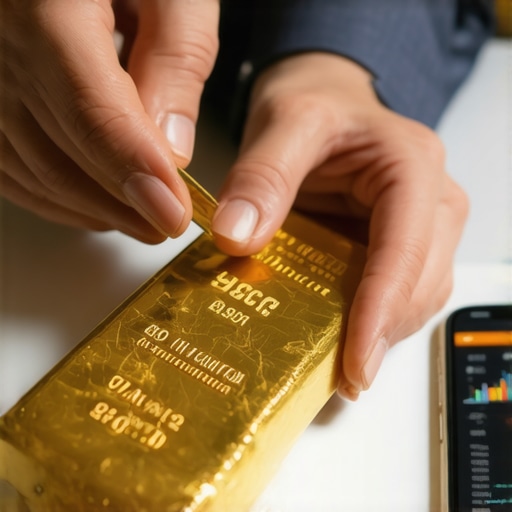Understanding Gold Investment: A Beginner’s Guide
Investing in gold has always been a popular choice for those looking to diversify their portfolios and hedge against inflation. As a tangible asset with intrinsic value, gold offers stability in uncertain economic times. For beginners, navigating the world of gold investment can seem daunting, but with the right practices and insights, it can be a rewarding journey. In this guide, we will explore the best practices for investing in gold effectively.
The Importance of Research in Gold Investments
Before diving into gold investments, it is crucial to conduct thorough research. Understanding the dynamics of the gold market, including its trends and historical performance, can help you make informed decisions. Familiarize yourself with the factors that influence gold prices, such as market demand, geopolitical events, and economic indicators. For more detailed insights, check out key insights on gold market trends that can guide your investment strategy.
Choosing the Right Type of Gold Investment
There are various forms of gold investments available, each with its advantages and disadvantages. Beginners often consider options such as gold coins, bullion, ETFs (Exchange-Traded Funds), and gold mining stocks. Understanding the differences is essential. For instance, physical gold, such as coins and bars, provides ownership of tangible assets, while gold ETFs offer a more liquid investment option without the need to store physical gold. For a comprehensive overview of the types of gold investments, refer to this resource.
Setting Investment Goals and Budget
Establishing clear investment goals is vital for success in gold investing. Are you looking to invest for the short-term or the long-term? Setting a budget will help you avoid overspending and keep your investments aligned with your financial objectives. It’s advisable to allocate only a small percentage of your portfolio to gold, as it should complement your overall investment strategy. For advice on maximizing returns, consider exploring smart gold ETFs tailored for your portfolio.
Understanding the Costs and Fees
Investing in gold isn’t just about the purchase price; there are additional costs and fees involved. For physical gold, consider factors such as premiums, storage fees, and insurance. In contrast, gold ETFs may come with management fees. Being aware of these costs will help you calculate the true expense of your investments. To learn more about managing these aspects, check out best practices for evaluating your gold investment portfolio.
Staying Informed and Adapting Strategies
Finally, the gold market is dynamic, and it is essential to stay informed about market trends and economic changes. Regularly reviewing your investment strategy and being open to adapting it based on new information can significantly enhance your chances of success. For up-to-date market forecasts and trends, visit this page for expert insights.
By following these best practices, beginners can navigate the gold investment landscape with confidence, making informed decisions that align with their financial goals. Gold remains a strong asset in any investment portfolio, and with the right approach, it can yield significant returns over time.
Developing a Gold Investment Strategy
A well-defined gold investment strategy is essential for successful investing. Begin by assessing your risk tolerance, which will help determine how much of your portfolio should be allocated to gold. Consider diversifying within your gold investments, as this can mitigate risk. For example, combining physical gold with gold ETFs can provide both security and liquidity. To explore effective gold investment strategies, refer to this guide.
Timing Your Gold Investments
Timing plays a critical role in gold investments. Understanding market cycles and price trends can aid in making informed investment decisions. Keep an eye on macroeconomic indicators, such as inflation rates and interest rates, which often influence gold prices. For insights into predicting gold prices, check out this resource that offers valuable forecasts and analysis.
Utilizing Gold ETFs and Other Investments
Gold ETFs are becoming increasingly popular due to their ease of use and lower overhead costs. They offer a way to invest in gold without the need for physical storage. When considering ETF investments, it’s crucial to evaluate the fund’s management fees and performance history. For a deeper dive into the best gold ETFs for your portfolio, visit this article.
Risks and Considerations in Gold Investment
Every investment carries risks, and gold is no exception. Market volatility can lead to fluctuations in gold prices, which can affect your investment’s value. Additionally, geopolitical events can have a significant impact on gold demand and supply, driving prices up or down. Understanding these risks is essential for any investor. For detailed insights on how to mitigate risks, see this post that covers potential pitfalls and rewards in gold mining investments.
Long-Term vs. Short-Term Investment Approaches
Deciding whether to invest in gold for the long term or short term can greatly influence your strategy. Long-term investors may benefit from the stability gold offers during economic downturns, while short-term traders might capitalize on market fluctuations. Assess your financial goals and market conditions to choose the best approach for you. For a comparative overview, check out this beginner’s guide that discusses various strategies.
Monitoring Your Gold Investments
Regularly reviewing and monitoring your gold investments is crucial to ensure they align with your financial goals. Keep track of market conditions and adjust your portfolio as necessary. Utilizing analytical tools and resources can provide valuable insights into performance. For assistance in evaluating your gold portfolio, explore this resource that outlines best practices for maintaining a robust investment strategy.
Investing in gold can be a rewarding venture when approached with careful planning and informed decision-making. By understanding the nuances of the gold market and developing a sound investment strategy, you can enhance your chances of achieving significant returns over time. Remember to stay informed and adapt your strategies to the ever-evolving market landscape.
Understanding Gold Market Trends and Analysis
To enhance your gold investment strategy, it is crucial to stay informed about the latest market trends. Analyzing gold price movements and understanding the factors that drive these changes can provide a competitive edge. Utilize analytical tools and market reports to track price fluctuations and identify patterns. For a comprehensive overview of gold market analysis, consider reading this insightful piece.
Factors Influencing Gold Prices
Gold prices are influenced by various factors including inflation, currency strength, and geopolitical events. As a hedge against inflation, gold often sees increased demand during economic uncertainty. Monitoring these factors can help you make informed decisions about when to buy or sell. Understanding the nuances of these influences can be vital for your investment success. For further details on key price influences, refer to this resource that breaks down critical elements affecting gold prices.
Exploring Different Types of Gold Investments
Diversifying your gold investments can lead to improved portfolio performance. Beyond physical gold bars and coins, consider options like gold mining stocks and gold ETFs. Each type of investment carries its own set of risks and rewards, so it’s essential to assess which aligns best with your investment goals. If you’re curious about different gold investment types, visit this guide for a detailed comparison.
Gold Coins vs. Gold Bars: Which is Better?
When deciding between gold coins and gold bars, consider factors such as liquidity, storage, and premiums. Gold coins can offer higher liquidity and are often more sought after by collectors, while gold bars generally have lower premiums over the spot price. Understanding these differences can help you make a more informed investment decision. For more insights on this topic, check out this article that discusses the advantages and disadvantages of both options.
Leveraging Gold for Retirement Investments
Investing in gold for retirement can provide a safety net against economic downturns. A Gold IRA allows you to include physical gold in your retirement account while enjoying tax advantages. It’s essential to understand the rules and regulations governing Gold IRAs to maximize your benefits. If you’re interested in learning more about this investment avenue, read this insightful post that outlines the key steps to start your Gold IRA journey.
Gold as a Long-Term Investment
Gold has historically been viewed as a long-term investment that can provide stability during market volatility. By holding gold over an extended period, you may benefit from its appreciation and hedge against inflation. Analyze your investment horizon and financial goals to determine how gold fits into your overall strategy. For further guidance on long-term gold investing, see this resource that offers strategic insights for 2025 investors.
Conclusion: Staying Informed for Success
In the dynamic world of gold investing, staying informed is paramount. By understanding market trends, diversifying your investments, and leveraging gold for retirement, you can enhance your overall investment strategy. Remember to continuously educate yourself and adapt to changing market conditions to maximize your returns.
Understanding Gold Market Dynamics
To effectively navigate the gold market, it’s essential to grasp the dynamics that influence gold prices. Market shifts can be driven by factors such as currency fluctuations, interest rates, and investor sentiment. Keeping abreast of these elements helps you make timely investment decisions. For a detailed analysis of current market dynamics, consider exploring this comprehensive resource.
Impact of Economic Indicators on Gold Prices
Economic indicators such as inflation rates, employment figures, and GDP growth play a significant role in shaping the gold market. When economic conditions are unstable, investors often flock to gold as a safe haven, driving prices up. Understanding these indicators can help you predict potential market movements. For further insights into how economic factors influence gold pricing, refer to this article that elaborates on key influences.
Investment Strategies for Gold in 2025
As you strategize your gold investments for 2025, consider diversifying your portfolio to mitigate risks. This can involve mixing physical gold, ETFs, and gold stocks to balance potential returns with stability. Each investment type offers unique advantages, and understanding these can enhance your investment approach. For a deeper dive into the various gold investment options, visit this guide that helps you identify the best fit for your goals.
Evaluating Gold ETFs and Their Benefits
Gold ETFs (Exchange-Traded Funds) have become an increasingly popular choice among investors seeking exposure to gold without the hassles of physical storage. They provide liquidity and ease of trading on the stock exchange. However, it’s crucial to understand the underlying assets and fees associated with these funds. For more information on the advantages of gold ETFs, check out this informative post.
Common Mistakes Investors Make in Gold
While investing in gold can be lucrative, many investors fall prey to common pitfalls. Failing to research thoroughly, succumbing to market hype, or neglecting to diversify can lead to costly mistakes. Being aware of these challenges is the first step in safeguarding your investment. For guidance on avoiding these pitfalls, consider reading this article that outlines critical errors to avoid.
Long-Term vs. Short-Term Gold Investments
Deciding between long-term and short-term gold investments depends on your financial goals and risk tolerance. Long-term investments in gold can provide stability and protection against inflation, while short-term trading may offer higher rewards with increased risk. Analyzing your investment strategy is vital to achieving optimal results. For further insights into this decision-making process, explore this resource that discusses effective strategies for both investment horizons.
Conclusion: The Future of Gold Investments
In conclusion, understanding the complexities of the gold market and developing a robust investment strategy is essential for success in 2025 and beyond. By staying informed about market dynamics, avoiding common mistakes, and exploring various investment types, you can enhance your gold portfolio effectively. Always remember to adapt to changing market conditions and continuously educate yourself for better investment outcomes.
Comprehensive FAQ Section on Gold Investment
1. What are the benefits of investing in gold in 2025?
Investing in gold offers several benefits, including portfolio diversification, protection against inflation, and serving as a hedge during economic uncertainty. Gold retains its value over time, making it an attractive option for long-term investments.
2. How do economic conditions affect gold prices?
Gold prices are influenced by economic conditions such as inflation rates, currency strength, and geopolitical stability. When the economy is unstable, demand for gold typically increases as investors seek safety, driving prices up.
3. Should I invest in physical gold or gold ETFs?
The choice between physical gold and gold ETFs depends on your investment strategy. Physical gold provides tangible value and can be a good hedge against inflation, while gold ETFs offer liquidity and ease of trading without the need for storage.
4. What common mistakes should I avoid when investing in gold?
Common mistakes include failing to conduct thorough research, not diversifying your portfolio, and giving in to market hype. It’s essential to stay informed and understand your investment goals to avoid these pitfalls.
5. How can I determine the right time to buy gold?
Determining the right time to buy gold involves monitoring market conditions, economic indicators, and historical price trends. Utilizing analytical tools and expert insights can help you make informed decisions.
6. Are gold stocks a good investment option?
Gold stocks can be a viable investment option, as they often provide leverage to the price of gold. However, they also come with specific risks related to mining operations and market volatility, so thorough research is essential.
7. How do I protect my gold investment?
To protect your gold investment, consider diversifying your holdings, keeping abreast of market trends, and regularly reviewing your investment strategy. Proper storage and insurance can also safeguard physical gold assets.
8. What is the long-term outlook for gold prices?
The long-term outlook for gold prices is generally positive, given ongoing economic uncertainties, inflationary pressures, and geopolitical tensions. However, prices can be volatile in the short term, so it’s important to maintain a long-term perspective.
9. How can I stay informed about gold market trends?
Staying informed about gold market trends can be achieved by following reputable financial news sources, subscribing to industry reports, and joining investment forums. Engaging with experts and connecting with other investors can also provide valuable insights.
10. What role do central banks play in the gold market?
Central banks play a significant role in the gold market as they hold substantial reserves and can influence gold prices through their buying and selling activities. Their policies on interest rates and currency can also impact the demand for gold.
Authority Resources for Gold Investment
For those looking to deepen their understanding of gold investment, the following resources are highly recommended:
- World Gold Council: A leading authority on gold and its role in the global economy, providing research and insights into gold investment.
- Kitco News: A trusted source for precious metals news, market data, and expert analysis on gold and other commodities.
- Investing.com – Gold: Offers comprehensive market data, news analysis, and tools for tracking gold prices and trends.
- Mining.com: Provides news and analysis on the mining sector, including updates on gold mining companies and market developments.
- Bloomberg Markets – Commodities: Features in-depth coverage of commodity markets, including gold, with access to expert commentary and analysis.
Conclusion: Navigating the Future of Gold Investments
As we look ahead to 2025, understanding the complexities of the gold market is more critical than ever. By addressing common questions and referencing authoritative resources, investors can enhance their strategies and make informed decisions. Remember, staying adaptable and informed is key to successfully navigating the gold investment landscape.











This comprehensive guide on gold investment really highlights the importance of approaching gold with a clear strategy and understanding. From my experience, the challenge for beginners often lies in deciding between physical gold and ETFs. I appreciate how the post emphasizes researching cost factors like premiums and storage fees for physical gold versus management fees for ETFs. Personally, I started with a small allocation in gold ETFs because they offered liquidity and ease of management, especially since I wasn’t ready to handle physical storage. Over time, I diversified by adding some physical coins to my portfolio for that tangible sense of security during volatile times. What I find interesting is balancing between these types to leverage liquidity and stability simultaneously. I’m curious, for others who have started investing in gold, how do you decide the right balance between physical and ETF gold? And do you find that your allocation changes with economic shifts or over the long term? I’d love to hear some practical insights from fellow investors on adapting strategies as market conditions evolve.